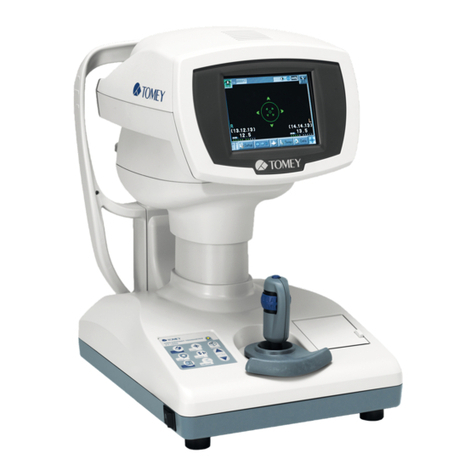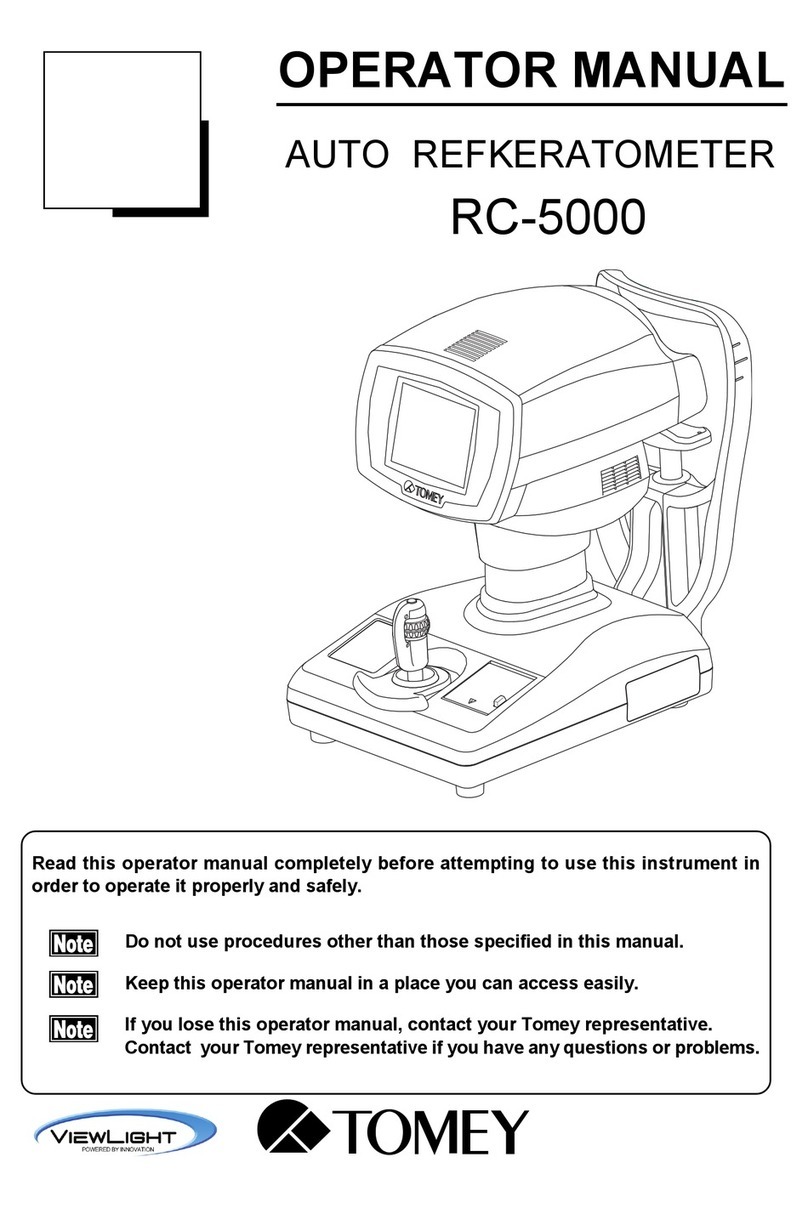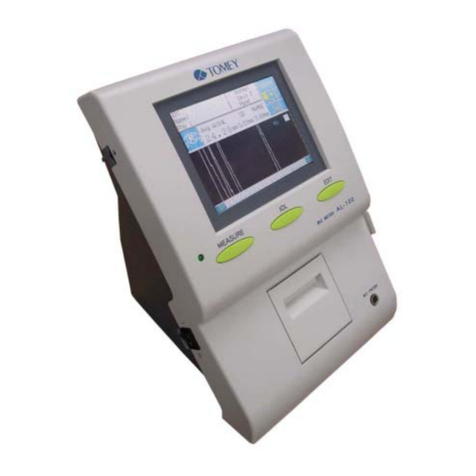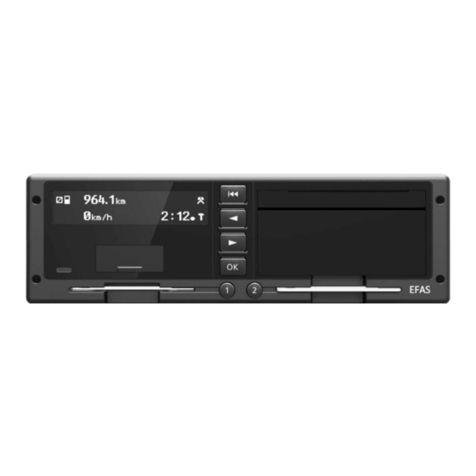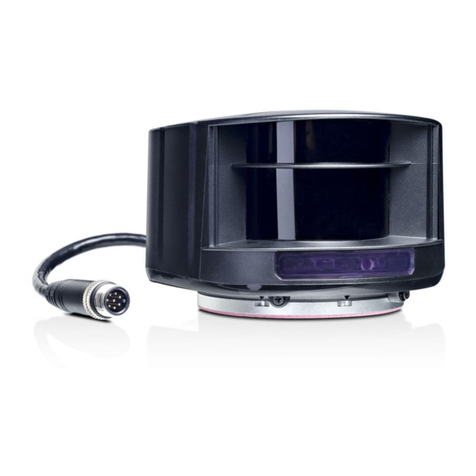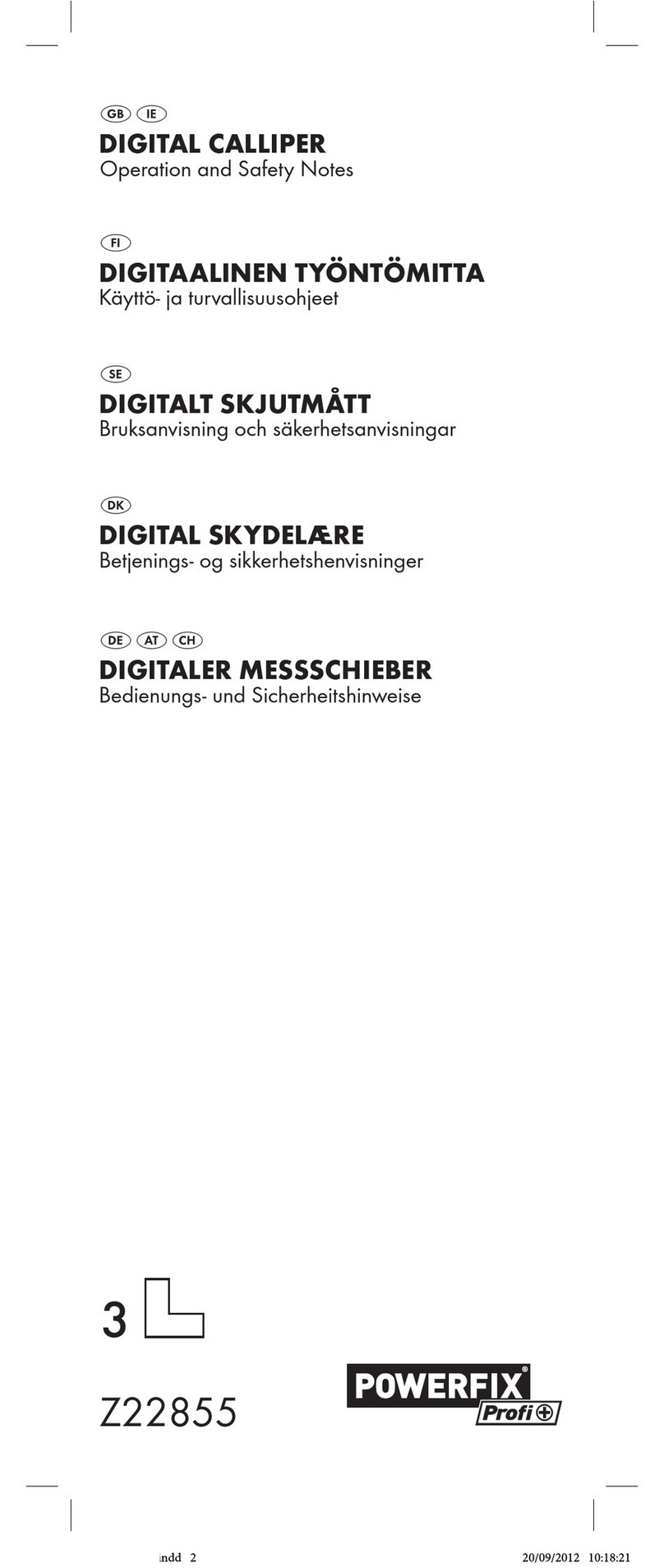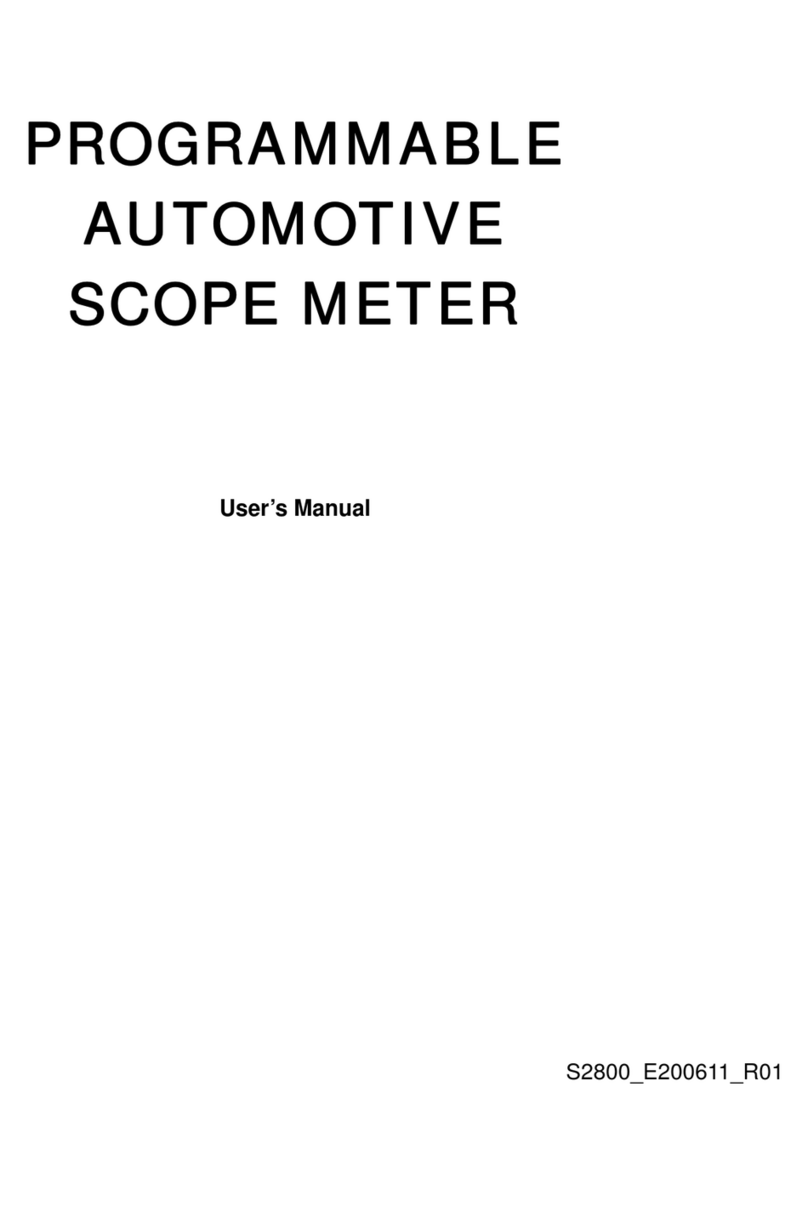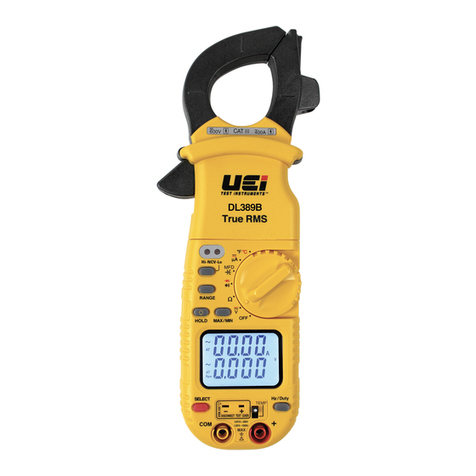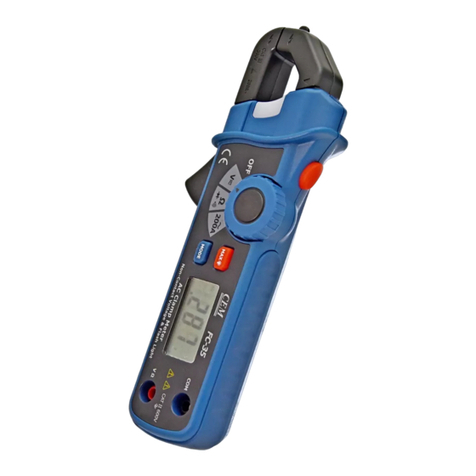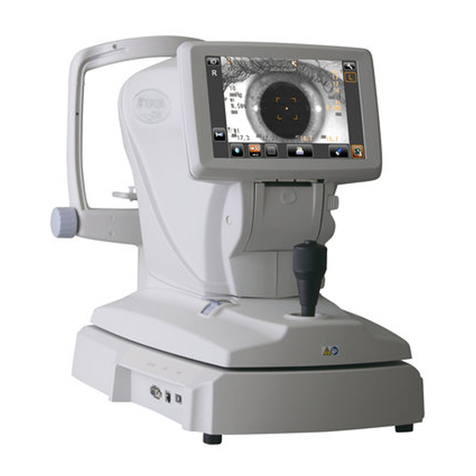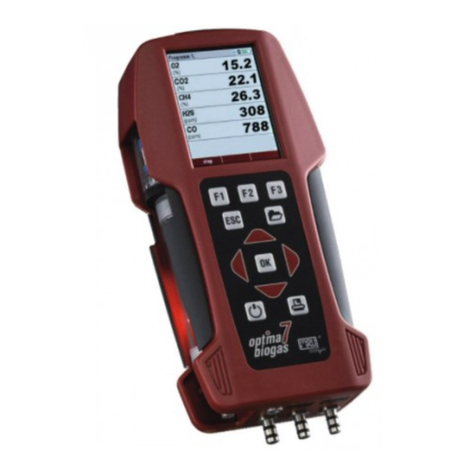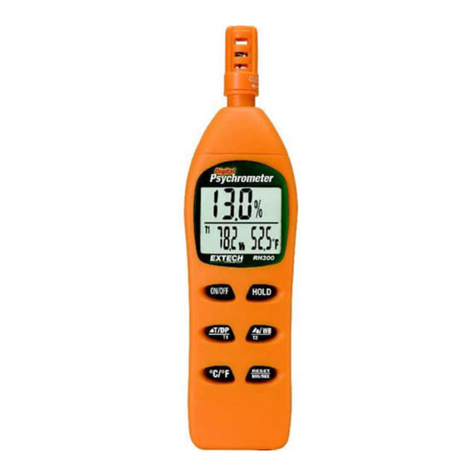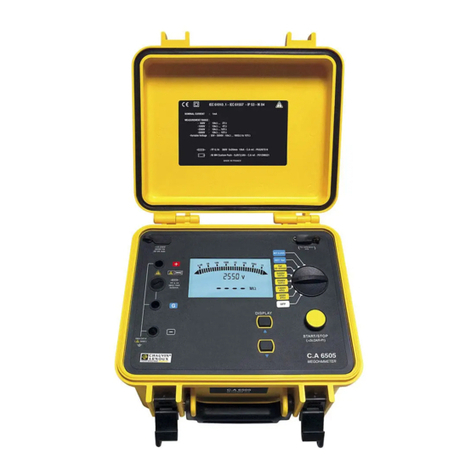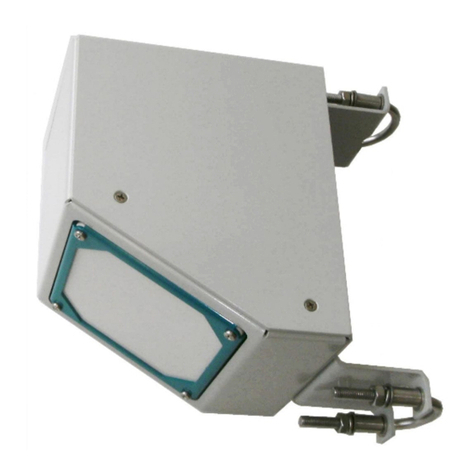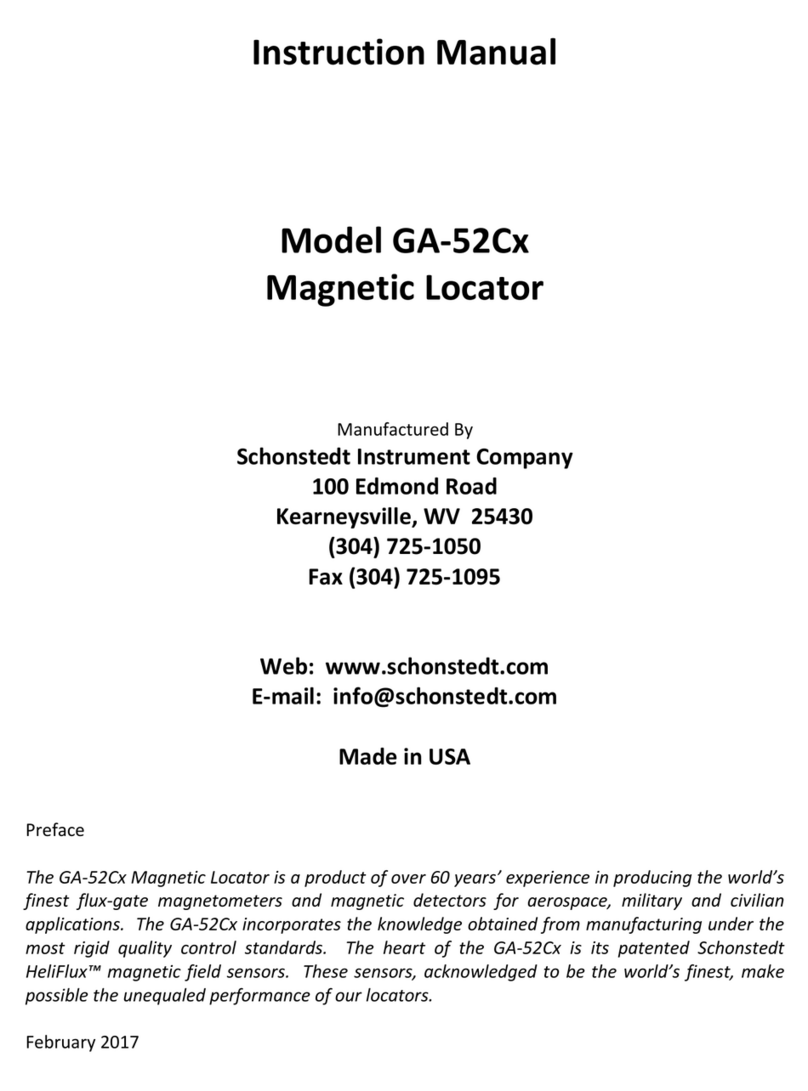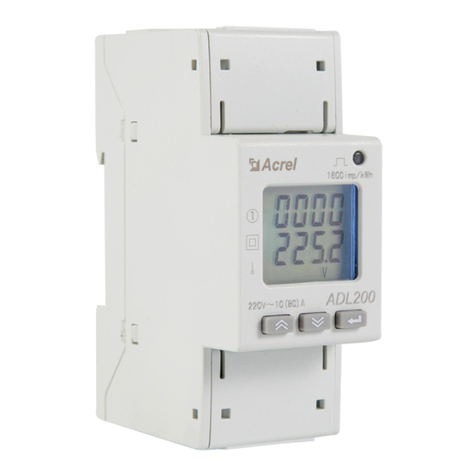Tomey UD-800 User manual

76AA9090-0J
INSTRUCTION MANUAL
ULTRASONIC A/B SCANNER
AND PACHYMETER
UD-800
Read this manual thoroughly before using the instrument to
ensure proper and safe operation.
Contact Tomey Corporation or your local distributor if you
have any questions or you encounter any problems during
operation.
■
Always follow the operation procedures
described in this manual.
■
Keep this manual in a readily accessible
location while operating the instrument.
■Contact your local distributor if you lose this
manual.


i-1
■
i. Important safety information
■
Do not install this instrument in a location where explosives or flammable
substances are used or stored. Otherwise, fire or explosion may occur.
■
Do not remove the cover of the instrument.
Otherwise electric shock may
result.
■
Do not disassemble or modify the instrument. Otherwise electric shock may
result.
■
Disconnect the power cord from all the connected devices before installing
and/or servicing the instrument. Otherwise, electric shock may result.
■
Sterilize probes and the eye cup before use.
■
Do not use probes and the eye cup with its contact section damaged.
Measurement error may occur, as well as the cornea or eyelid may be injured.
■
Do not commence service or maintenance work while the instrument is being
used for a patient.
■
Do not place water or chemicals on the instrument.
Any water or chemicals
entering the instrument may cause electric shock or failure.
■
Do not allow water or chemicals to splash on probes, except for the tip cap.
Any water or chemicals entering the instrument may cause electric shock or
failure.
■
Use only the specified data terminal for connection of the instrument.
Using
another type of terminal may result in failure of the instrument.
■
This instrument is a diagnostic/measuring device specially designed for
ophthalmology.
Never use the instrument for other purposes.
■
The terminal for connecting the instrument to external devices is not isolated
from the internal circuit.
Inappropriate wiring may damage the internal circuit.
Never touch any of these terminals and the patient at the same time.
Be sure to
contact Tomey or your local distributor before using the external output
terminal.
■
When operating this instrument connected to other devices, use only devices
that satisfy IEC60601-1 or equivalent safety requirements, or that conform to
IEC60950 and whose power source is isolated with an isolation transformer, in
order to satisfy the relevant safety requirements for medical equipment.

■
i-2
This page is intentionally left blank.

ii-1
■
ii. How to read this manual
Outline
This manual is structured as follows.
1. PRIOR TO USE
Describes safety precautions and important information to be
understood before installing and using the instrument.
2. NAMES AND FUNCTIONS
Describes names and functions of each section of the instrument.
3. OPERATION PROCEDURES
Describes information required for installing and using the
instrument.
4. TECHNICAL INFORMATION
Describes useful technical information about the instrument.
5. INSPECTION AND MAINTENANCE
Describes procedures for replacing consumable parts, etc. that
the user of the instrument should normally conduct.
6. TROUBLESHOOTING
Describes how to solve problems.
7. CONSUMABLES AND OPTIONAL EQUIPMENT
Describes consumable parts and optional equipment.
8. SPECIFICATIONS
Describes the specifications of the instrument.

■
ii-2
Symbols used in this manual
Sentences accompanied with the symbols below indicate the following:
■This is a precaution that, if unheeded, will result
in a hazardous situation where there is an
imminent danger of serious injury or death.
■This is a precaution that, if unheeded, could
result in a hazardous situation where there is a
possibility of serious injury or death.
■This is a precaution that, if unheeded, may result
in a situation where there is a possibility of
minor or moderate injury or damage to
property.
■This is an additional instruction which may
contain a special precaution on company
policy related, either directly or indirectly, to
the safety of personnel or to the protection of
property.

iii-1
■
iii. Contents
i. Important safety information.............................................................................................. i-1
ii. How to read this manual..................................................................................................... ii-1
Outline.................................................................................................................................................. ii-1
Symbols used in this manual............................................................................................................... ii-2
iii. Contents ............................................................................................................................. iii-1
1. PRIOR TO USE .................................................................................................................... 1-1
1.1 Precautions for operation .............................................................................................................. 1-1
1.2 Checking package contents .......................................................................................................... 1-5
1.3 Glossary......................................................................................................................................... 1-6
1.4 Overview........................................................................................................................................ 1-9
2. NAMES AND FUNCTIONS................................................................................................... 2-1
2.1 Front of the main unit..................................................................................................................... 2-1
2.2 Back of the main unit..................................................................................................................... 2-2
2.3 Sides of the main unit.................................................................................................................... 2-3
2.4 Screen............................................................................................................................................ 2-4
2.4.1 Common items........................................................................................................................ 2-4
2.4.2 B mode image diagnosis screen ............................................................................................ 2-5
2.4.3 Axial length measurement/view screen.................................................................................. 2-7
2.4.4 Pachymetry screen................................................................................................................. 2-9
2.4.5 A-Diag measurement screen................................................................................................ 2-10
2.5 Symbols used for marking........................................................................................................... 2-12
3. OPERATION PROCEDURES............................................................................................... 3-1
3.1 Preparation before use.................................................................................................................. 3-1
3.1.1 Connections............................................................................................................................ 3-1
3.1.2 Turning the power on and adjustment after turning the power on......................................... 3-5
3.1.3 Switching modes..................................................................................................................... 3-5
3.1.4 Entering the patient data ........................................................................................................ 3-6
3.1.5 Deleting all measurement data (measurement preparation for other patient)....................... 3-9
3.1.6 Selecting an eye ..................................................................................................................... 3-9
3.2 B mode image diagnosis ............................................................................................................. 3-10
3.2.1 Settings related to measurement ......................................................................................... 3-10
3.2.2 Displaying probe angle ......................................................................................................... 3-10
3.2.3 Gain adjustment.................................................................................................................... 3-12
3.2.4 Patient preparation ............................................................................................................... 3-13

■
iii-2
3.2.5 Obtaining ultrasonic image................................................................................................... 3-14
3.2.6 Various functions .................................................................................................................. 3-15
3.3 Biometry function......................................................................................................................... 3-22
3.3.1 Setting measurement conditions.......................................................................................... 3-22
3.3.2 Operation check.................................................................................................................... 3-25
3.3.3 Preparation for measurement............................................................................................... 3-25
3.3.4 Precautions for measurement .............................................................................................. 3-26
3.3.5 Measurement:....................................................................................................................... 3-32
3.3.6 Checking waveforms after measurement............................................................................. 3-35
3.4 IOL power calculation .................................................................................................................. 3-38
3.4.1 Calculation............................................................................................................................ 3-38
3.4.2 Entering calculation parameters........................................................................................... 3-38
3.4.3 Setting calculation formula ................................................................................................... 3-43
3.4.4 Entering data after surgery................................................................................................... 3-44
3.5 Statistical processing................................................................................................................... 3-45
3.6 Pachymetry function .................................................................................................................... 3-47
3.6.1 Setting the data type to be displayed................................................................................... 3-47
3.6.2 Setting measurement conditions.......................................................................................... 3-47
3.6.3 Displaying and setting measurement points ........................................................................ 3-49
3.6.4 Operation check.................................................................................................................... 3-50
3.6.5 Preparation for measurement............................................................................................... 3-50
3.6.6 Measurement:....................................................................................................................... 3-51
3.6.7 Checking measurement data ............................................................................................... 3-52
3.7 A mode diagnosis......................................................................................................................... 3-56
3.7.1 Connecting the probe ........................................................................................................... 3-56
3.7.2 Switching to A mode diagnosis function............................................................................... 3-56
3.7.3 Registering Ref. Data ........................................................................................................... 3-56
3.7.4 Measurement:....................................................................................................................... 3-57
3.7.5 Setting gain........................................................................................................................... 3-57
3.7.6 Switching data display .......................................................................................................... 3-58
3.7.7 Setting the beam direction.................................................................................................... 3-58
3.7.8 Gradation characteristics function........................................................................................ 3-59
3.7.9 Analysis functions................................................................................................................. 3-59
3.8 Export, print, and save................................................................................................................. 3-61
3.8.1 Export.................................................................................................................................... 3-61
3.8.2 Print....................................................................................................................................... 3-63
3.8.3 Saved data management ..................................................................................................... 3-70
3.9 System setup............................................................................................................................... 3-73

iii-3
■
3.9.1 General ................................................................................................................................. 3-74
3.9.2 Measurement........................................................................................................................ 3-76
3.9.3 Application ............................................................................................................................ 3-81
3.9.4 Connecting & Printing........................................................................................................... 3-83
4. TECHNICAL INFORMATION ............................................................................................... 4-1
4.1 IOL power calculation formula....................................................................................................... 4-1
4.1.1 Haigis optimized / Haigis Standard ........................................................................................ 4-1
4.1.2 Hoffer®Q formula ................................................................................................................... 4-3
4.1.3 Holladay 1............................................................................................................................... 4-5
4.1.4 SRK-II formula ........................................................................................................................ 4-7
4.1.5 SRK/T formula ........................................................................................................................ 4-9
4.1.6 SRK SHOWA formula........................................................................................................... 4-11
4.1.7 Shammas-PL formula........................................................................................................... 4-12
4.1.8 SRK/T Double K ................................................................................................................... 4-14
4.2 How to calculate axial length using the biometry function .......................................................... 4-16
4.2.1 Phakic eye ............................................................................................................................ 4-16
4.2.2 Dense cataract eye............................................................................................................... 4-16
4.2.3 Aphakic eye .......................................................................................................................... 4-16
4.2.4 IOL eye ................................................................................................................................. 4-16
4.3 Amplifier characteristics of the A-scan diagnosis ........................................................................ 4-18
4.4 Ultrasonic wave output ................................................................................................................ 4-18
5. INSPECTION AND MAINTENANCE .................................................................................... 5-1
5.1 Warranty ........................................................................................................................................ 5-1
5.2 Operation life ................................................................................................................................. 5-2
5.3 Inspection ...................................................................................................................................... 5-2
5.4 Routine maintenance..................................................................................................................... 5-2
5.4.1 Maintenance of measurement probes.................................................................................... 5-2
5.4.2 Cleaning and Disinfection of measurement probes (for Europe)........................................... 5-4
5.4.3 Maintenance of main unit ....................................................................................................... 5-6
5.5 Replacing consumables ................................................................................................................ 5-7
5.5.1 Fuses ...................................................................................................................................... 5-7
5.5.2 Printer paper........................................................................................................................... 5-7
5.6 Storing............................................................................................................................................ 5-8
5.7 Disposal ......................................................................................................................................... 5-8
6. TROUBLESHOOTING ......................................................................................................... 6-1
6.1 Common items............................................................................................................................... 6-1
6.2 B mode image diagnosis ............................................................................................................... 6-3

■
iii-4
6.3 Biometry function........................................................................................................................... 6-5
6.4 Pachymetry function ...................................................................................................................... 6-8
7. CONSUMABLES AND OPTIONAL EQUIPMENT ................................................................ 7-1
7.1 Spare parts .................................................................................................................................... 7-1
7.2 Optional parts ................................................................................................................................ 7-1
8. SPECIFICATIONS ................................................................................................................ 8-1
8.1 Specifications................................................................................................................................. 8-1
8.2 Quantity of ultrasonic energy......................................................................................................... 8-5
8.3 Noise.............................................................................................................................................. 8-7
8.4 Operating environment.................................................................................................................. 8-7
8.5 Classification of ME equipment ..................................................................................................... 8-7
8.6 Declaration of conformity to EMC.................................................................................................. 8-9

1-1
■
1. PRIOR TO USE
■
Read this manual thoroughly before using this instrument to ensure
proper and safe operation.
■
Always follow the operation procedures described in this manual.
■
Check that there are no devices that generate a strong magnetic field
near the instrument. A strong magnetic field may cause noise and
affect measurement.
■
Do not place any other objects on this instrument.
1.1 Precautions for operation
■
Allow only qualified operators to use the instrument.
■
When using the IOL calculation result to select intraocular lenses, also thoroughly
examine cataract surgery methods and other inspections to determine the
selection.
■
The ultrasound images may contain artifacts.If the image is doubtful, consider
other examinations to carefully determine whether to adopt the value.
■
Precautions when installing the instrument and accessories
-Install the instrument in a location free of water or chemicals. Any water or chemicals
entering the instrument or devices may cause electric shock or failure.
-Do not install the instrument in a location where chemicals are stored or gases may
occur.
Any chemicals or vapor entering the devices may result in fire.
-Check the frequency, voltage, and allowable current (or power consumption) of the
power source. Otherwise, fire or electric shock may occur.
-Connect the power plug to a grounded 3-pin outlet. Otherwise, a short circuit due to
failure of the instrument may result in electric shock.
-Do not place any heavy object on the power cord or squash the power cord. Fire or
electric shock may occur.

■
1-2
-Fully insert the power plug into the outlet. Faulty contact, allowing any metal to
contact the exposed terminal of the plug, or dust accumulated on the exposed
terminal of the plug may result in fire or electric shock.
-Conduct grounding work correctly. Otherwise, you may get electric shock.
-Do not connect a device with data transmission specifications that are not
compatible. Fire or electric shock may occur. Contact Tomey Corporation or your
local distributor before using the instrument while connected to another device.
-If there is a problem with the instrument, turn off the power switch and disconnect the
power plug. Install the instrument in a place where this can be performed smoothly.
-Install the instrument in a location not subject to direct sunlight, high temperature
and humidity, or air containing dust, salt, and/or sulfur. Otherwise, failure or
malfunction may occur.
-Install the instrument in a leveled stable location free of vibration or mechanical
impact. Otherwise, measurement cannot be conducted correctly. Also, the
instrument may topple or fall, resulting in fire or a serious accident.
-Install the instrument in a location with ample clearance from other devices to allow
smooth inspection.
■
Precautions during operation
-Do not allow water or chemicals to splash onto the B mode probe, except for the tip
cap. Any water or chemicals entering the instrument may cause electric shock or
failure.
■
Precautions before operation
-Check the electrical contact of switches, polarity, dial setting, and meters, and that
the instrument is working correctly.
-Check that all cables are connected correctly.
-Since simultaneous use of multiple devices can cause misdiagnosis or result in a
hazardous situation, exercise caution when using this instrument.
-Check the sections that the patient will directly touch.
-Check that the instrument is correctly grounded.
-Check that the date set in the instrument conforms to the actual operation date and
time.

1-3
■
■
Precautions during operation
-Do not place any container with liquid in it on the instrument. Any liquid entering the
instrument may cause electric shock or failure.
-Do not allow the patient to touch the terminals for connecting the instrument to
external devices.
-Do not lean on the instrument or press the instrument from the top. The instrument
may topple over, resulting in mechanical failure or injuries.
-Be extremely careful not to take too much time or too many measurements, as this
can stress the patient.
-Constantly observe that both the instrument and patient are free of problems.
-If a problem with the instrument or the patient occurs, take appropriate action, such
as stopping the device, to ensure the patient's safety.
-Do not allow the patient to touch the instrument.
-If any smoke, offensive odor, or abnormal sound occurs, turn off the instrument
immediately, disconnect the power plug from the outlet, and contact your local
distributor or Tomey Corporation.
■
Precautions after operation
-Do not place any container with liquid in it on the instrument. Any liquid entering the
instrument may cause electric shock or failure.
-Do not use organic solvents such as thinner, benzene, or acetone to clean the
instrument. Fire or electric shock may occur. (These solvents may also corrode the
resin or coating on the cover of the instrument.)
-Follow the specified procedures to return the operation switch, dial, etc. to their
original positions and turn the instrument off.
-Hold the plug when disconnecting the power plug from the outlet to avoid placing
excessive force on the cord.
Pulling the cord may damage the inner core wires,
resulting in electric shock or fire.
-When disconnecting cords, do not apply too much force to them, for example, do not
hold and pull the cord.
-Refer to "5.6 Storing" for instructions on the storage of the instrument.
-Clean the instrument at the end of operation in preparation for the next use.

■
1-4
-Clean and neatly arrange the accessories and cables.
■
If any failure occurs in the instrument, immediately stop operation, indicate the
failure in the instrument, and contact your local distributor for repairs.
-Do not modify the instrument. Doing so may cause electric shock or failure of the
instrument. There is a high-voltage section in the instrument. Touching this section
will result in death or serious injuries.
-Disconnect the power cord from the outlet when replacing fuses. Otherwise, you
may get electric shock, resulting in death or serious injuries.
-Use the power cord and fuses provided with the instrument or specified by Tomey to
ensure safety. Also, do not use the accessories provided with the instrument for
other equipment.
-Conduct regular inspections of the instrument and components.
-When any instrument failure occurs, indicate the failure, and contact your local
distributor to request inspection and repair. Do not attempt to repair the instrument
yourself.
-When the instrument has not been is use for 1 month or longer, check that the
instrument is operating correctly and safely before starting operation.
Refer to "5.3
Inspection" in this manual for the relevant procedures.

1-5
■
1.2 Checking package contents
Open the package and check that the required quantity of the following items is
included and they are not damaged. If any item is missing or damaged, contact
your local distributor as soon as possible.
■
Keep the box and packing materials for use when moving or
transporting the instrument.
■
When taking the instrument out of the box, pull the outer box upward
and then remove the packing materials. Be careful not to lift the
instrument up by directly holding the head, chin rest, forehead pad,
joystick, or cables. The instrument may be damaged.
●Main unit
●10MHz B probe············································ 1
●Power code················································· 1
●Foot switch·················································· 1
●Printer paper ··············································· 1
●Ultrasound gel ············································· 1
●Fuse ·························································· 4
(Two are included as accessories)
●Dust cover ·················································· 1
●Instruction manual (this manual) ···················· 1
●DATA Transfer installation CD ························· 1
●DATA Transfer startup guide ··························· 1

■
1-6
1.3 Glossary
[ACD]
:
Anterior chamber measurement
[Acrylic]
:
Acrylic lens
[Aphakic]
:
Aphakic eye
[AVG]
:
Average value
[Axial]
:
Axial length measurement
[B-Mode]
:
B mode image diagnosis
[Calibration]
:
Calibration of B mode probes and pachymetry probes
[CCT]
:
Corneal center thickness
[Contact]
:
Method of taking measurements by directly applying the contact
section of the biometry probe to the center of the cornea
[Clinical History Method]
:
Method of calculating the corneal refractive power before
refractive correction surgery. This is used together with the
Double K Method.
[D]
:
Diopter. The unit of refractive power representing the level of
myopia, hyperopia, or astigmatism. Reciprocal of the focal
length measured in meters.
[DATA Transfer]
:
System to output the examination data created by TOMEY
products as a file
[Export]
:
To send measurement data to DATA Transfer or Tomey Link.
[FREEZE]
:
Status where ultrasound waves are not transmitted
[Immersion]
:
Measurement mode when applying cornea protective agent
between the contact section of the axial length probe and the
cornea.
[IOL]
:
Intraocular lens
[K1]
:
Radius of corneal curvature of minor meridian [mm or D]
[K2]
:
Radius of corneal curvature of major meridian [mm or D]
[Obj.]
:
Section to be measured
[Pachy]
:
Measurement of corneal thickness
[Pre]
:
Before refractive power correction surgery
[Phakic]
:
Phakic eye

1-7
■
[PL]
:
Abbreviation of POST LASIK
[PMMA]
:
PMMA lens
[Post]
:
After refractive power correction surgery
[Ref.]
:
Reference section
[Silicone]
:
Silicone lens
[SNR]
:
S/N (signal to noise) ratio
A larger value represents less noise, meaning higher quality
signals can be obtained.
[TOMEY Link]
:
Digital medical record system to manage data measured with
Tomey products
[VD] (Vertex distance)
:
Distance between corneal vertexes [mm]
Represents the distance between the corneal vertex and the
posterior surface of the lenses to be prescribed.
When (VD=CL), vertex distance is calculated as 0 mm.
[Auto Power Off function]
:
The LCD turns off automatically when no operation is conducted
for a specified time. (Auto power off mode)
Touch any button to return to Normal mode.
[Caliper]
:
Manually move the measurement point.
[Gray scale]
:
Indicates the range of gradation values to be measured in
images represented in shades from white to black.
[Gain]
:
Adjusts amplification, brightness of images, and amplitude of
waveforms.
[Gate]
:
Specifies the range of waveforms to be detected.
[Smoothing]
:
This function smoothes the continuation of images and reduces
noises, improving the image quality.
[Measurement point]
:
Indicates the point where corneal thickness is measured,
specified by diameter and angle.
[Touch panel]
:
Allows you to make various settings, etc. by directly touching
the monitor.
[Harmonic]
:
Image composition method for ultrasound diagnosis which uses
harmonic components of ultrasonic waves.
[Bias value]
:
Value obtained by converting actual measurements using a
specified percentage or correction value

■
1-8
[Vector A mode]
:
Indicates the direction of ultrasonic wave transmission and
displays the A mode waveform.
[Real time]
:
Status where ultrasound waves are transmitted

1-9
■
1.4 Overview
This instrument is designed as an ophthalmology device with functions to retrieve
ultrasound topographic images of living tissues using ultrasound waves
generated from an ultrasound transducer built into the probe, to retrieve A mode
waveforms and to measure axial length and corneal thickness.
B mode image diagnosis function
●From the B mode probe connected to the main unit, images and displays the
tissue of the scanned eyeball cross section generating and scanning
ultrasound waves into the eyeball and using ultrasonic echoes reflected from
each tissue inside the eyeball.
Biometry function
●The measurement probe connected to this instrument transmits ultrasound
waves to the inside of an eyeball and then receives ultrasound echoes
reflected by the tissue boundary surface in the eyeball.
●The time required for the ultrasound wave to be transmitted from the front of
the cornea to the measurement section is measured, and the length of the
living tissue is calculated based on the preset converted acoustic velocity.
L: Length of living tissue
V: Converted sound speed
t: Measurement time
●With an IOL power calculation function, this instrument has various IOL
power formulae applicable to ordinary cataract surgery and/or cataract
surgery of eyes with corrected corneal refractive power, and provides data
necessary to determine IOL power.
Pachymetry function
●Function to measure corneal thickness in the same manner as measurement
of axial length
A mode diagnosis
●Function to identify areas with pathocological changes by observing A mode
waveforms

■
1-10
This page is intentionally left blank.
Table of contents
Other Tomey Measuring Instrument manuals
